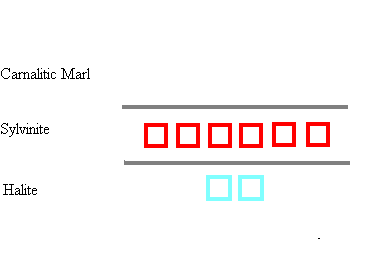
|
Humberside Geologist No. 12
Six members of the Hull Geological Society, set off early in the morning over the misty Moors to visit the Cleveland Potash Mine at Boulby (just west of Staithes). In spite of the weather we arrived early and were shown a video about the mine, works and the uses of potash. We were also given a short talk by the senior geologist.
After a talk about safety and with our heads reeling from the statistics we were issued with hard hats, lamps, masks, ear plugs and emergency respirators. Passing through three sets of heavy doors that form an air lock, we entered the lift cage to descend into the deepest mine in the UK, with the sound of 290 cubic metres per second of air being forced down the mine by the main fans.
The descent in the cage was very smooth and then our guide Peter Roberts drove us about 5 kilometres to the deepest working face of the mine, about 1300 metres underground. Here the temperature is 42 degrees Celsius (about 108 degrees Fahrenheit), before the machinery starts working, which raises it further!
The mine is worked in Zechstein Cycle 3 evaporites of Permian age. Two roadways are cut into the underlying halite deposit; this rock salt being sold for road gritting. The halite has a shiny light grey appearance, with no discernible bedding. From the main roadways, they drive up into the weaker Sylvinite deposits, which contain about 40% Potassium Chloride (Potash) and 50% Sodium Chloride. The sylvinite is mostly brick red in colour but there are lenses of grey shale and pure white Potash. Peter showed us a simple test for the potash, it tastes salty like the halite, but also tingles on your tongue. The sylvinite is not as structurally strong as the halite and is mined in six parallel tunnels, leaving 2.5 to 4 metre wide pillars between them, which allow a controlled rate of collapse of the tunnels. That is why we were not allowed to collect samples or even stand near the sides of the tunnels. It is quite a strange feeling being so far underground and listening to the tunnel you are in slowly collapsing! Above the sylvinite is the Carnallitic Marl, containing magnesium salts.
Economic reserves of potash were discovered in the 1930s, during test drilling for oil. It was not until the 1970s that Cleveland Potash Ltd, was formed and started work on the current mine. The mining is carried out using "Heliminer" continuous mining machines, with horizontal rotary cutters four metres wide on hydraulically operated booms. The machines cost £1,500,000 each, weigh nearly 90 tonnes and operate electrically using 3,300 volts. At the time of our visit, they were being progressively converted from cab control to remote control, to get the operator further away from the dust and the risk of blow outs if they hit pockets of high pressure nitrogen gas. The largest electric motor in the northern hemisphere at 7000 hp is used to haul the ore to the surface.
Geologists monitor the progress of each tunnel daily to ensure that they do not get too close to the overlying marl. They drill a series of 50mm x 22m bore holes every morning to test the deposits ahead. The pile of tailings from the hole is visually examined and samples are taken for testing. A "Gammatrol probe" is pushed into the hole on a long fibreglass rod and records the radioactivity from the small amounts of potassium 40 isotope, which indicates the percentage of potash in the ore. The roof must not be allowed to get thinner than 1.5 metres or it will break, allowing the Carnallitic Marl to flow into the tunnel under pressure. The geologist marks the headings for the heliminer to follow on the tunnel wall with spray paint, before leaving for the surface to enter the details on the mine's master plan.

After our underground tour lasting three thirsty hours and a quick lunch, Mark Wilson led us on a tour of the processing plant. 3 million tonnes of sylvinite are mined each year and produce 1 million tonnes of potash, mostly for use as a fertiliser. We were shown how the ore is crushed, concentrated by froth flotation, centrifuged and dried. A purer white form is produced by recrystallisation. The waste clay and saline solution is pumped out to sea. The finished products are transported by the company?s own rail wagon fleet and by road haulage.
We would like to thank Peter Roberts and Mark Wilson for showing us around and Lyn Marsay for arranging the visit. We would also like to thank Lyn Marsay and Roger Holmes for reading and correcting an early draft of this article.
copyright Hull Geological Society 2020